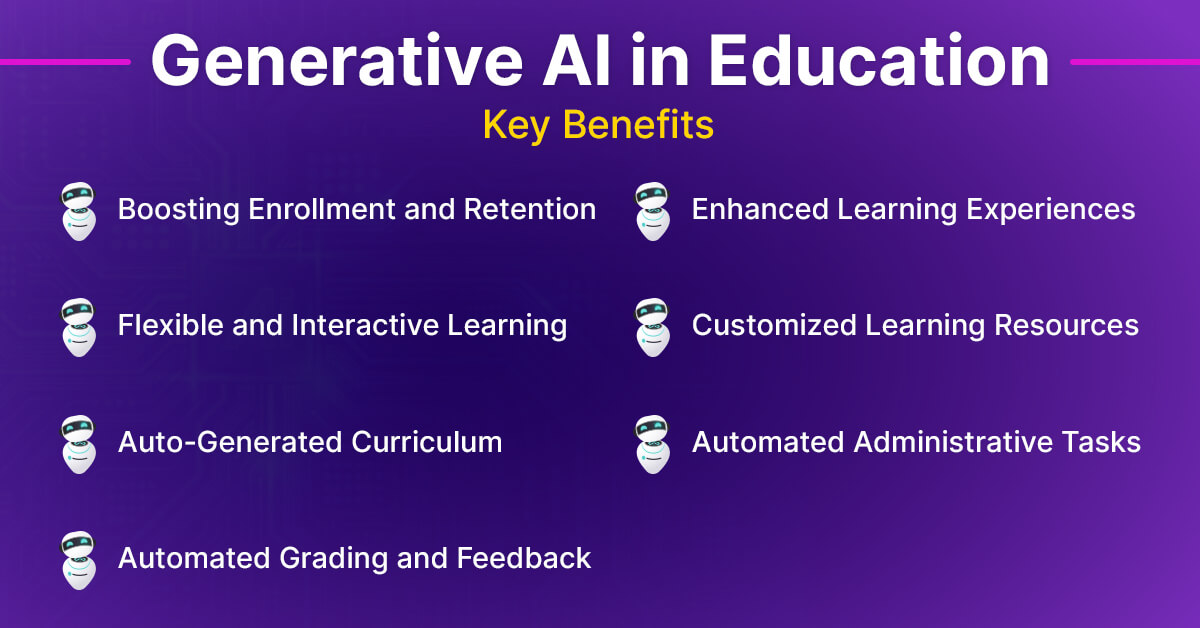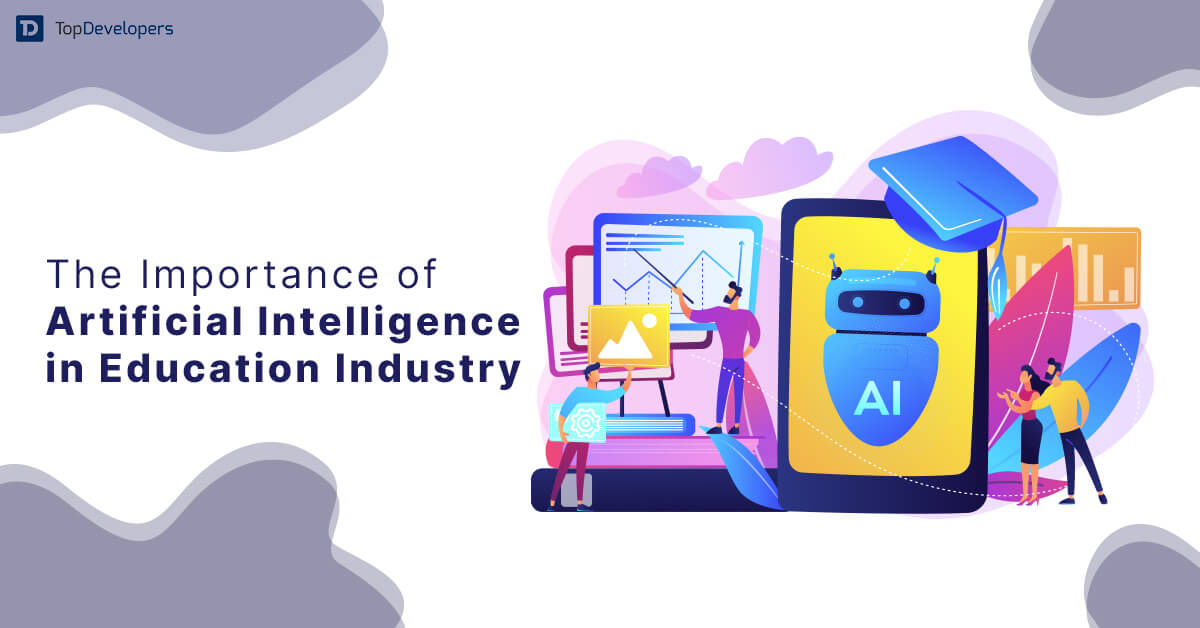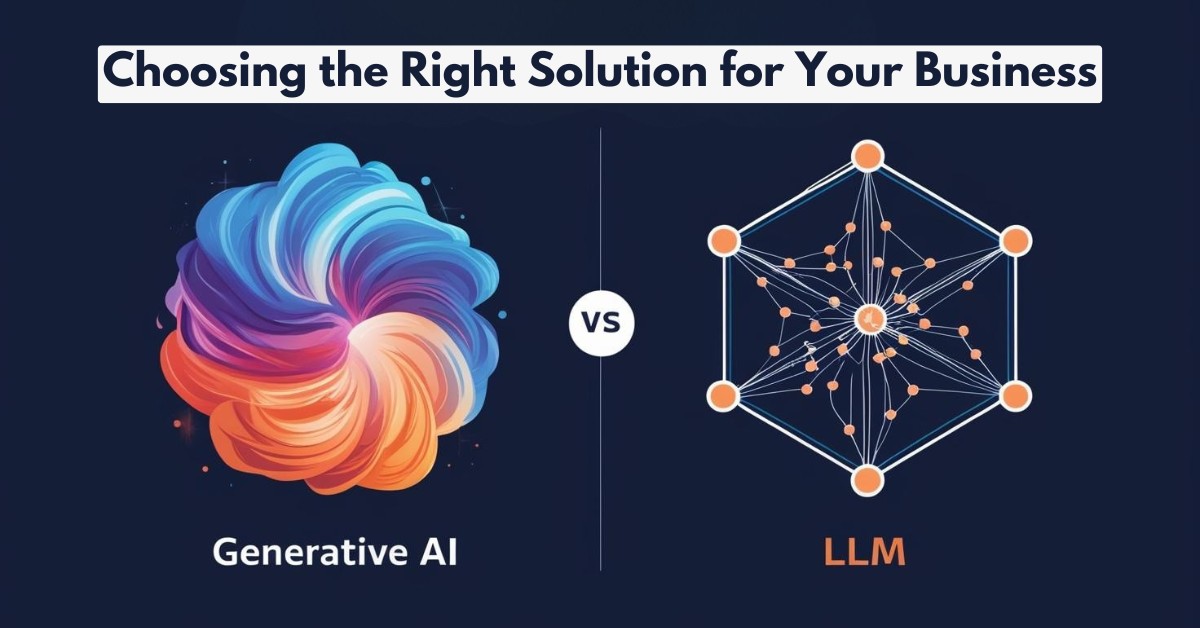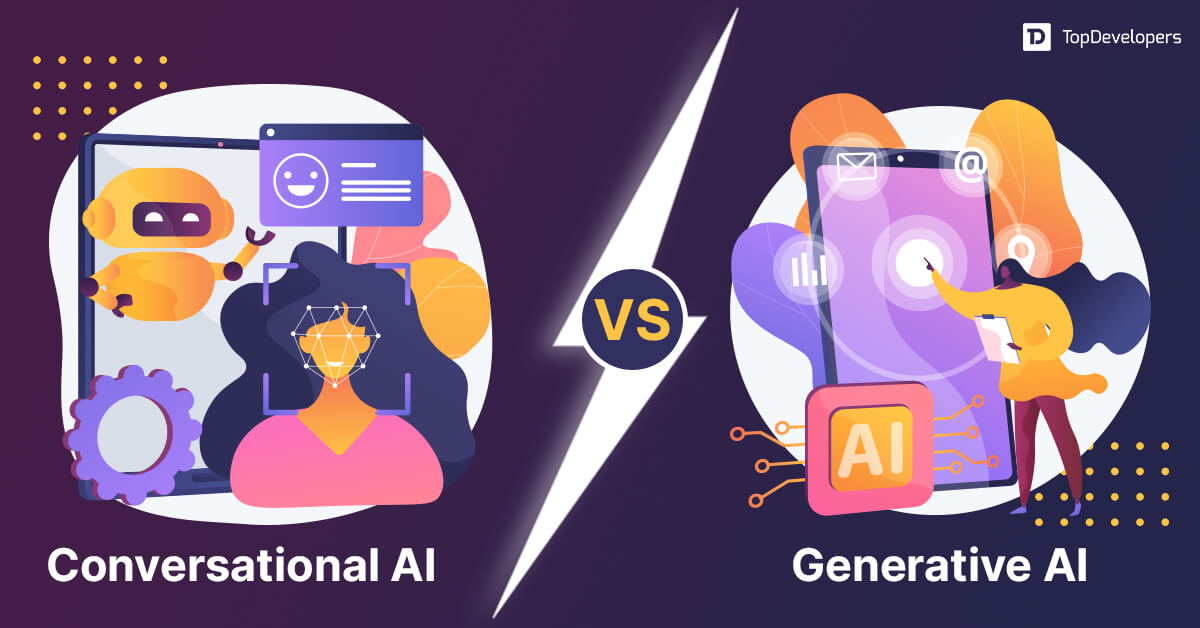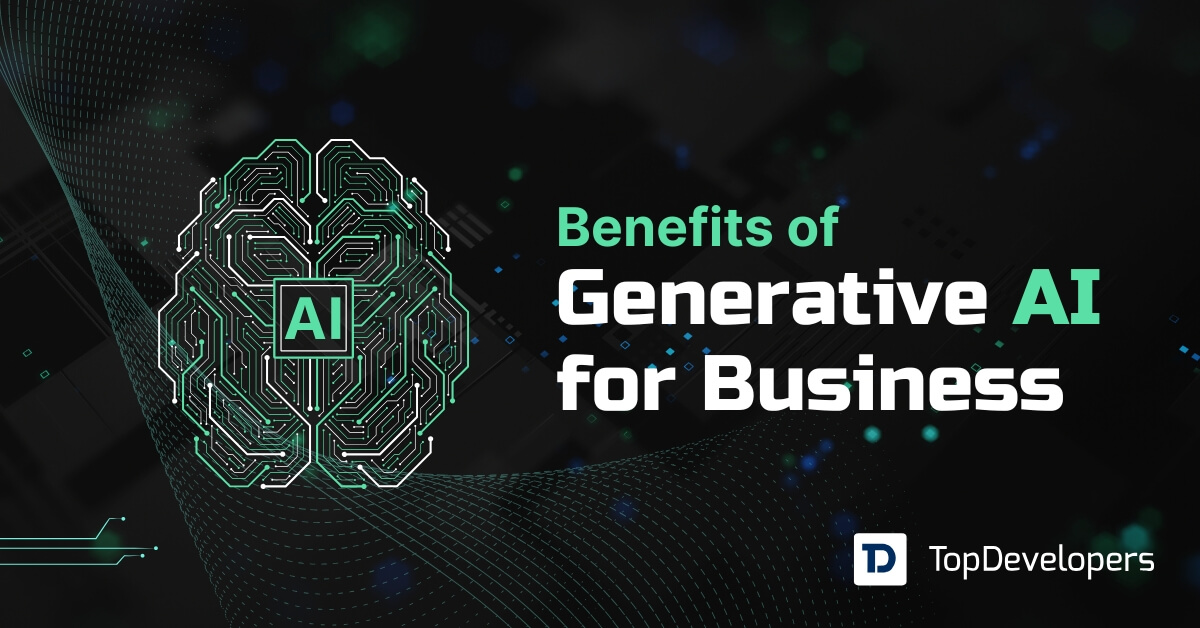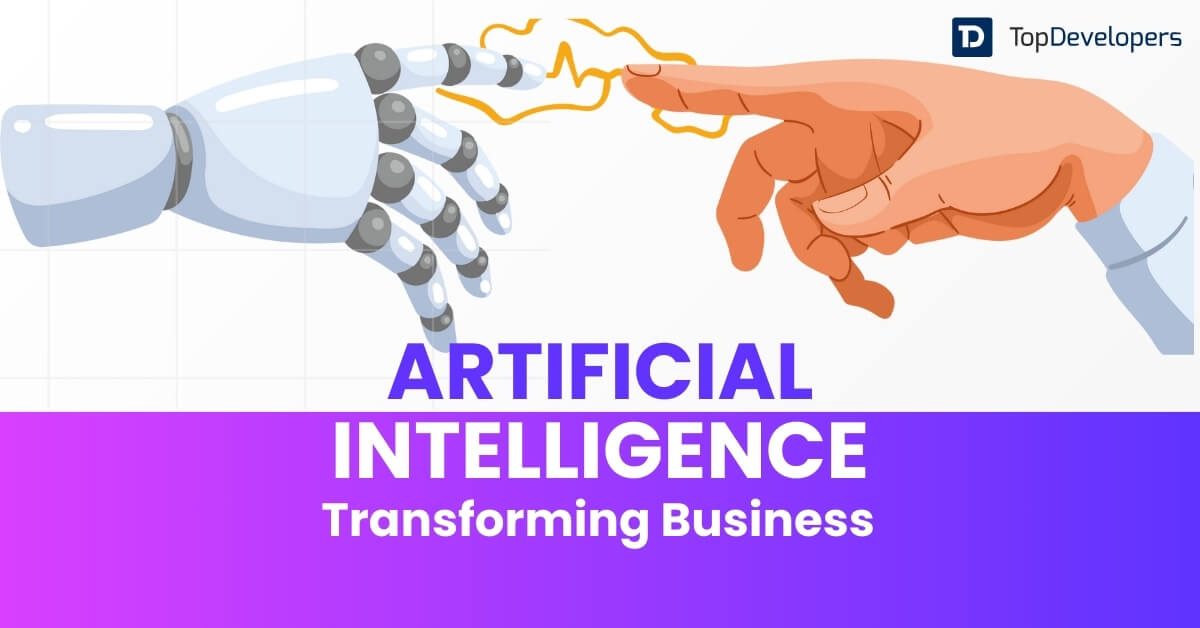
A brief review of the conventional educational system reveals a set of courses meant for every class in the institution. However, the conventional curriculum lacks the flexibility to cater to individual student preferences, making it incapable of captivating them. It also prevents instructors from improving their methods of instruction and guiding their pupils in certain directions.
Revolutionary generative AI tech is transforming the education system into a more responsive, modern one. Educational organizations can add dynamism everywhere, including personalized learning experiences, streamline teaching efforts, automate assignment creation, and improve operational efficiency with administrative task automation by connecting with Generative AI development companies.
This blog will explore how generative AI represents a significant advancement in the history of education systems and explore its implications for educators, students, and the learning environment.
Table of Contents
- The Rise of Generative AI in Education
- What Does Generative AI Mean for the Education Industry?
- Key Impacts of Generative AI on Education
- 1. Personalized Learning Experiences
- 2. Automated Content Creation
- 3. Real-Time Feedback and Assessment
- 4. Enhanced Creativity and Critical Thinking
- 5. Virtual Tutoring and Support
- 6. Gamified and Interactive Learning
- 7. Predictive Analytics for Student Success
- 8. Collaborative Learning Environments
- 9. Language Learning and Accessibility
- 10. Restoration and Enhancement of Learning Materials
- Seven Benefits of Using Generative AI in Education
- Increasing students’ enrollment and retention
- Relevant, flexible, and interactive learning capabilities
- Auto-generate educational curriculum
- Provide grading and feedback to the students
- Engineer transmogrifying learning experiences
- Customize learning resources attuned to students’ progress
- Repetitive administrative tasks get automated
- Unleash the Potential of Generative AI in Education!
- Conclusion
The Rise of Generative AI in Education
Driven by sophisticated models like large language models (LLMs) and neural networks, generative artificial intelligence may generate text, graphics, simulations, and even code catered to particular requirements. Its capacity in education to grasp context, produce human-like answers, and constantly adjust makes it a great tool. Generative artificial intelligence is mostly responsible for the 45% increase in AI use in education predicted by McKinsey in 2024, from 2020. Driven by artificial intelligence, the worldwide EdTech industry is expected to reach $404 billion by 2028, rising at a CAGR of 16.3% (Grand View Research, 2024).
The technology’s allure comes from its adaptability; it can create interactive materials, create customized lesson plans, and even replicate real-world events for experiential learning. Generative artificial intelligence is transforming education at all levels—from K–12 to higher education and lifelong learning—as schools, colleges, and institutions mix various technologies.
What Does Generative AI Mean for the Education Industry?
Generative artificial intelligence technologies, which use machine learning techniques to identify patterns in current data, are a type of artificial intelligence that specifically generates new and original content. Modern technologies democratized the education sector by customizing learning experiences in line with students’ tastes, therefore empowering them. The education system is shifting from rote memorization to a focus on understanding.
Luckily, generative AI drives change for customized lesson planning and development in teaching strategies. By means of auto-assessment based on student success, educators may concentrate on enhancing teaching strategies and appreciating the possibilities of generative AI; so, educational institutions cooperate with AI developers to reach academic goals on the digital road.
Let’s explore some use cases that enable the education sector to redefine its capabilities and enhance outcomes.
Key Impacts of Generative AI on Education
1. Personalized Learning Experiences
Generative artificial intelligence uses student data—including prior performance, skill set, and feedback—to develop tailored lesson plans and learning materials. This addresses personal requirements, learning styles, and pace, therefore enhancing the effectiveness and enjoyment of education.
2. Automated Content Creation
Lesson plans, tests, study aids, and multimedia tools are just a few of the instructional resources AI can provide. This automation guarantees materials stay updated and relevant and saves teachers a great amount of time.
3. Real-Time Feedback and Assessment
Instant feedback on student work powered by artificial intelligence lets students fix errors and expand knowledge right away. Automated grading and practical insights into student development help teachers.
4. Enhanced Creativity and Critical Thinking
DALL-E and Midjourney are among generative artificial intelligence technologies that let pupils creatively solve problems and see abstract ideas. Stories and situations created by artificial intelligence also encourage creativity and critical thinking
5. Virtual Tutoring and Support
AI-powered virtual tutors and chatbots provide individualized assistance outside of the classroom, therefore enabling support for every student—including those with limited access to in-person aid or learning difficulties.
6. Gamified and Interactive Learning
Interactive quizzes, simulations, and gamified learning experiences developed with artificial intelligence help to raise student involvement and information retention.
7. Predictive Analytics for Student Success
By means of data pattern analysis, artificial intelligence forecasts student performance and detects individuals who run the danger of lagging behind, therefore facilitating prompt interventions and higher retention rates.
8. Collaborative Learning Environments
Generative artificial intelligence organizes student groups, manages resources, and creates virtual workplaces, thus facilitating group projects and collaborative learning.
9. Language Learning and Accessibility
For non-native speakers and students with impairments, AI systems provide real-time translation, grammatical corrections, and pronunciation help, thereby including them in education.
10. Restoration and Enhancement of Learning Materials
Using artificial intelligence helps to make them more interesting and easily available for contemporary students.
Let’s explore different use cases that enable education spaces to redefine capabilities and enhance outcomes.
Seven Benefits of Using Generative AI in Education
Generative AI is transforming education by enhancing learning experiences, streamlining processes, and fostering inclusivity. Below are seven key benefits of using generative AI in the education industry, supported by examples and data. For educational institutions, professors, and students themselves, integrating generative AI into the system offers many benefits. Let’s explore potential uses of generative AI in the sector of education to bring
Increasing students’ enrollment and retention
Many times, modern students choose to study under educational institutions that provide a unique learning route for every student matched with their academic objectives. Adaptive learning environments seen in educational institutions usually translate into higher enrollment. At a CAGR of 12.5%, the adaptive learning market is estimated to rise to $2.87 billion by 2024. It shows that generative AI is being embraced by educational institutions to fit the learning environment to every student’s requirements, thereby increasing student enrollment.
For instance, the solution automatically offers advanced materials to read and raises the challenge level when pupils shine in one topic. On the other hand, more instructional resources are given to explain ideas when pupils find learning challenging. Adaptive learning keeps the pupils for the following criteria after they graduate.
Relevant, flexible, and interactive learning capabilities
Many times, students need more help when they struggle to grasp difficult ideas. Generative artificial intelligence can quickly explain to pupils real-life examples using natural language processing. The quick reply keeps the students interested and helps them to believe that conversations are more human. To stay effective, the generative AI solutions help students through the problem-solving process while analyzing their work, past interactions, and academic aspirations.
Appropriate suggestions help one grasp the idea more deeply than would be possible if subject-matter specialists were not there. Solutions allowing students to study at their leisure and at their learning speed regardless of time zone variations allow them to do so.
Auto-generate educational curriculum
Planning courses for various classes takes a lot of effort and money spent by educational institutions. Generative artificial intelligence shines in sorting and organizing vast amounts of data, which is advantageous for the construction of courses in line with different dynamics. For the mathematics course of class fifth, generative AI-powered content creation tools, for instance, will produce the syllabus and list the lessons to learn along with question papers and presentations.
It saves enormous sums of money for academic institutions and removes the need for additional personnel for the creation of the curriculum. The saved time may also be utilized strategically to plan ways to raise user interaction in a learning environment centered on students.
Provide grading and feedback to the students
Generative artificial intelligence is so strong that its evaluation skills transcend multiple-choice question (MCQ) correct answer identification. It may assess every student’s critical thinking abilities and evaluate the many responses—including essays. For educational institutions, where multiple classes give courses to students depending on their performance and development, such automated grading system deployment is a blessing.
Generative AI solutions provide thorough contextual responses that function as helpful comments for pupils. It points out areas that need work and provides specific recommendations for materials to raise test results.
Engineer transmogrifying learning experiences
Immersion simulations that almost seem real-life-like are not easy to forget. With AI or VR-powered simulations, generative artificial intelligence lets one create immersive experiences. Learning experiences become much more important when one can see and control objects in real-world surroundings. It helps one to understand abstract ideas, by which one does better academically.
By means of virtual activities enabled by AI-driven AR/VR technologies, educational institutions may also save money on building scientific laboratories or field excursions. The experiences are readily customized depending on courses and utilized again, therefore optimizing the ROI.
Customize learning resources attuned to students’ progress
Students are not limited to studying in one language just as the globe is becoming a global community. Generative artificial intelligence solutions for all pupils effectively control linguistic variations within the same class. Regardless of language, the AI interface guarantees that the instructional materials in a given language stay relevant depending on the performance and advancement of the learner.
Moreover, generative AI systems let students create tasks in their mother tongue and then show outcomes along with ideas for development. It makes studying rather easy and helps to save additional money for hiring translators or using translating services.
Repetitive administrative tasks get automated
Most teachers nowadays concentrate on raising students’ performance by means of greater student interactions. Teachers working with their students instead of devoting their time to course design, assessment development, and other administrative chores will be able to do this. In less than half of the time used by human labor, generative artificial intelligence brilliantly handles administrative chores.
For instance, the tedious chore of automatically evaluating student applications based on a few criteria is done. AI-driven systems take attendance using face recognition technologies, so teachers do not have to record attendance in the classroom. AI systems may examine examinations in context and provide progress reports with comments on student development. The technology can scan enormous volumes of data and provide insights to support data-driven choices.
You may also like: Why is Artificial Intelligence Important in Education?
Unleash the Potential of Generative AI in Education!
Bringing great advantages and problems, generative artificial intelligence is now the next frontier of the educational sector. With a growth rate (CAGR) of 35.82% from 2024 to 2032, the worldwide AI education market is predicted to reach $55.3 billion by 2032. Generative artificial intelligence offers chances to revolutionize learning and get a competitive advantage by means of promising solutions for educators, instructors, and students themselves. With generative AI used in the educational system, let’s rethink experiences in learning and teaching all around.
Conclusion
Offering hitherto unheard-of chances for personalization, efficiency, and innovation, generative artificial intelligence represents the future horizon for the education sector. Its general acceptance is already changing the way instructors teach and students learn, therefore opening the path for a more inclusive, interesting, and successful educational experience. Through customizing learning, improving engagement, and operational simplification, generative artificial intelligence is revolutionizing the educational industry.
Unmatched in capacity to scale excellent education worldwide and lower costs, issues like equality, prejudice, and privacy must be resolved if we are to fully realize its promise. Generative artificial intelligence will change education as institutions embrace ethical frameworks and invest in infrastructure, becoming more inclusive, interesting, and future-ready.
FAQs
1. What is generative AI and how is it used in the education industry?
Generative AI refers to AI models that can create new content such as text, images, or code. In education, it’s used for generating personalized learning materials, creating quizzes, automating content generation, and tutoring support.
2. What are the key benefits of generative AI in education?
Generative AI enhances learning by offering customized content, supporting multiple learning styles, automating repetitive tasks for educators, improving engagement, and enabling real-time feedback and assessment.
3. How is generative AI transforming teaching and learning experiences?
Generative AI transforms education by creating interactive simulations, auto-generating lecture notes, supporting personalized lesson planning, and enabling AI-driven tutoring platforms that adapt to each student’s needs.
4. What are real-world examples of generative AI in education?
Examples include ChatGPT for tutoring and essay writing, Khanmigo by Khan Academy for personalized instruction, Quizlet using AI for flashcard generation, and Jasper AI for educational content creation.
5. What challenges does the education sector face in adopting generative AI?
Challenges include ensuring data privacy, preventing misuse or plagiarism, maintaining content accuracy, training educators to use AI effectively, and addressing equity in access to AI-powered tools.
 Avantika Shergil
| Jun 17, 2025
Avantika Shergil
| Jun 17, 2025
Avantika Shergil is a technology enthusiast and thought leader with deep expertise in software development and web technologies. With over 8 years of experience analyzing and evaluating cutting-edge digital solutions, Avantika has a knack for demystifying complex tech trends. Her insights into modern programming frameworks, system architecture, and web innovation have empowered businesses to make informed decisions in the ever-evolving tech landscape. Avantika is passionate about bridging the gap between technology and business strategy, helping businesses build customized software and website, and understand about different tools to leverage effectively for their ventures. Explore her work for a unique perspective on the future of digital innovation.

